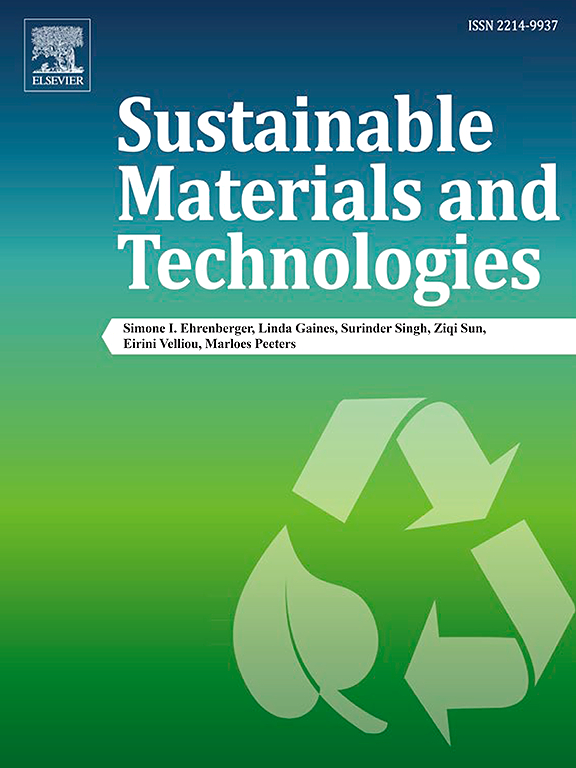Electronic modulation of nickel sites via Cu-doping and sulfur oxyanions coordination for highly efficient ammonia electrooxidation to nitrite production
IF 8.6
2区 工程技术
Q1 ENERGY & FUELS
引用次数: 0
Abstract
Electrocatalytic ammonia oxidation (AOR) offers an energy-efficient alternative to electrochemical water splitting for hydrogen (H2) production and the sustainable synthesis of high-value nitrogen-containing species, such as nitrites. To optimize this process, designing catalysts for selective ammonia-to-nitrite electrooxidation with enhanced electron transfer and high current density is practically important. Nickel-based materials are effective AOR catalysts, particularly through the self-oxidation reconstruction into NiOOH. However, pristine NiOOH typically yields multiple products and catalyzes the competing oxygen evolution reaction (OER) within a similar potential range, hindering the high selectivity required for valuable AOR products. Herein, we report a Cu-doped nickel sulfide catalyst (Cu-NiS2) with an optimized electronic configuration, which undergoes surface reconstruction to form sulfur oxyanion-coordinated Cu-NiOOH-SOx at ∼1.60 V vs. RHE. The incorporation of Cu facilitates electron transfer in Ni, while the SOx anions refines the coordination environment of Ni, modulating its electronic structure and enabling balanced adsorption of nitrogen-containing intermediates. This synergistic effect enhances both AOR activity and selectivity. As a result, the catalyst achieves an exceptional AOR current density of 104.8 mA cm−2 at 1.65 V, along with an ammonia conversion efficiency of 90.3 % over 8-h and a NO2− selectivity of 95.4 %. Notably, the Cu-NiS2 catalyst demonstrates remarkable stability, maintaining consistent performance for 56 h. This work provides new insights into the design and regulation of active sites in transition metal compound catalysts for efficient AOR, paving the way for selective nitrite production.

铜掺杂和硫氧离子配位对镍位的电子调制用于高效氨电氧化制亚硝酸盐
电催化氨氧化(AOR)为氢(H2)生产和高价值含氮物质(如亚硝酸盐)的可持续合成提供了一种替代电化学水分解的节能方法。为了优化这一过程,设计具有增强电子转移和高电流密度的氨-亚硝酸盐选择性电氧化催化剂具有重要的现实意义。镍基材料是有效的AOR催化剂,特别是通过自氧化重构成NiOOH。然而,原始NiOOH通常会产生多种产物,并在相似的电位范围内催化竞争性析氧反应(OER),从而阻碍了有价值的AOR产物所需的高选择性。在此,我们报道了一种具有优化电子结构的cu掺杂硫化镍催化剂(Cu-NiS2),该催化剂在~ 1.60 V与RHE下进行表面重构,形成硫氧阴离子配位的cu - nioh - sox。Cu的加入促进了Ni中的电子转移,而SOx阴离子改善了Ni的配位环境,调节了其电子结构,使含氮中间体的吸附平衡。这种协同效应增强了AOR活性和选择性。结果表明,该催化剂在1.65 V下的AOR电流密度为104.8 mA cm−2,8 h内氨转化率为90.3%,NO2−选择性为95.4%。值得注意的是,Cu-NiS2催化剂表现出了显著的稳定性,在56小时内保持了一致的性能。这项工作为高效AOR过渡金属化合物催化剂活性位点的设计和调控提供了新的见解,为选择性亚硝酸盐的产生铺平了道路。
本文章由计算机程序翻译,如有差异,请以英文原文为准。
求助全文
约1分钟内获得全文
求助全文
来源期刊

Sustainable Materials and Technologies
Energy-Renewable Energy, Sustainability and the Environment
CiteScore
13.40
自引率
4.20%
发文量
158
审稿时长
45 days
期刊介绍:
Sustainable Materials and Technologies (SM&T), an international, cross-disciplinary, fully open access journal published by Elsevier, focuses on original full-length research articles and reviews. It covers applied or fundamental science of nano-, micro-, meso-, and macro-scale aspects of materials and technologies for sustainable development. SM&T gives special attention to contributions that bridge the knowledge gap between materials and system designs.
 求助内容:
求助内容: 应助结果提醒方式:
应助结果提醒方式:


